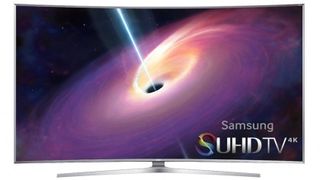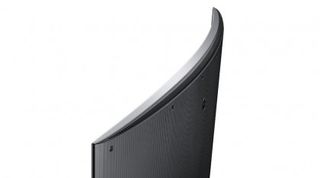Why you can trust TechRadar
Unlocking the UE65JS9000's full potential right away with HDR UHD clips of The Life OF Pi and Exodus supplied on USB for my tests, my first thought was that somehow Samsung really has managed to recapture the HDR glories of the UE65JS9500 at a far lower price point.
For starters, its pictures when using the provided presets are incredibly bright by LCD standards. The overall impact of this hits you right away, grabbing your attention and pulling you into the image like no edge LED TV before.
Colours are phenomenally vibrant, as fearsomely intense saturations and a huge dynamic colour range (courtesy of the Nano Crystal technology) are driven out of the screen by the UE65JS9000's extreme brightness.
That's just the most instantly obvious of the UE65JS9000's colour attractions, too. Longer examination reveals beautiful subtlety in the screen's rendering of colour blends and tonal shifts – something that underlines the screen's UHD resolution, creating an almost 'Super UHD' sensation at times.
Just as importantly, while stunningly bold, the UE65JS9000's colours never look unbalanced or unnatural. On the contrary, the richness of the colours on show feels more natural than the much flatter tones we've become used to with pre-HDR TVs.
Also making a stellar first impression is the UE65JS9000's contrast performance. It delivers incredibly punchy, pure whites at one end of the light spectrum, but also, more crucially – and, to be honest, unexpectedly – delivers strikingly deep, inky blacks. Often within the same frame.
This is particularly important in 'selling' HDR as a technology, and leaves the same Exodus/Life Of Pi clips on a non-HDR TV looking almost miserably flat and compressed by comparison.
The UE65JS9000's 65-inch screen is plenty big enough, meanwhile, to easily display the benefits of its UHD resolution – in fact, with the higher-than-usual brightness output you can feel the extra detailing even more clearly.
The UE65JS9000's thirst for detail even extends to dark scenes in a way you just don't get with less bright LCD TVs. In short, the UE65JS9000 proves that HDR and UHD are a match made in AV heaven.
Fortunately, though, given the current painful lack of native HDR and even UHD content, the UE65JS9000's visual splendour isn't restricted to native HDR UHD material.
The groundbreaking brightness and colour potency Samsung has installed in its latest TV to service HDR can also boost the look of normal Blu-rays and broadcasts. Colours look more richly saturated and vibrant, brightness levels are much higher, and the sense of contrast is far more defined and expansive.
To be clear, the richness and dynamic range of non-HDR images falls substantially short of the intensity delivered with native HDR content.

But it's equally clear that the UE65JS9000 can reproduce standard video signals with way more punch than normal TVs, so you do get some genuine extra picture quality for your money, even ahead of real HDR content heaving into view.
There are occasionally problems associated with the processing required to 'turn up' non-HDR content. If there's noise in a source, it can sometimes become rather amplified, some colours (especially oranges) occasionally look a little dominant and forced, and occasionally some shadow detail can get crushed out of dark scenes.
But the positives comfortably outweigh the negatives – and anyway, if you're one of those people who just has to stick with the Rec 709 standard with non-HDR content, fear not: the TV carries settings that deliver exactly that. Though my suspicion is that even the most die-hard of AV purists may find this Rec 709 mode starting to look painfully flat once they've tried the UE65JS9000's more dynamic options.
Another key strength of the UE65JS9000 concerns its upscaling to UHD of the HD sources that will make up the majority of a typical user's content right now.
Samsung delivered a strikingly effective upscaling solution last year, but this year it's moved things forward again, managing to add just as much detail and texture to HD sources, while at the same time reducing the potential for object edges to look stressy or images to tip over into grittiness.
In other news not directly associated with the UE65JS9000's HDR or UHD properties, motion is strikingly natural in its appearance without the need to introduce any motion processing higher than the relatively low-powered Clear mode.
Also, if you're sat relatively close central to the UE65JS9000's images the curved screen can help to create a sense of depth in pictures that really makes you feel more involved in the action.
The UE65JS9000's hugely impressive performance continues with 3D. Interest in 3D at home appears to be pretty niche these days, but if every TV gave as good a 3D account of itself as the UE65JS9000, 3D's popularity would surely rise again.
For instance, the extra brightness and colour intensity of this Samsung's pictures helps 3D images enjoy a superb sense of solidity and depth, suggesting that the new generation of ultra-bright, HDR-friendly LCD panels is going to be even more of a friend to 3D than 2D.
Also, the UE65JS9000's use of the active rather than passive 3D system means that 3D Blu-rays are upscaled to UHD, which helps the 3D world look more densely textured and, as a result, more tangible and immersive.
There is a small amount of crosstalk ghosting noise in the UE65JS9000's 3D images, but this is far less aggressive and common than I'd feared it might be, considering how bright the TV is.
While the UE65JS9000 strikes me for the most part as a spectacular early taste of the future of television, it does have a couple of limitations you need to be aware of.
First, if you stick with Samsung's picture presets and/or you feel inclined to drive the screen with its backlight set almost to maximum, then you'll find dark scenes afflicted by some quite distracting backlight clouding areas.
You'll need to reduce the backlight setting to around its 13-14 level before the clouding really starts to reduce, and even get down to around the 10 setting – about 50% of maximum brightness – to solve the issue if you're watching in a very dark room.
While this fix is relatively easy to accomplish, it does have wider implications. Namely that by reducing so much brightness from the image you no longer get as much impact from HDR content as you do with the UE65JS9500, which thanks to its direct backlighting can be run on a much higher level of brightness without suffering major backlight clouding problems.

The other things to be wary of both concern the UE65JS9000's curved screen. First, if your seating position finds you watching from an angle down the side of more than 30-35 degrees, the curve can cause the shape of the picture to look distorted.
Second, if you have a bright light source or some reflective furniture in your house, the reflections these can cause on the TV screen tend to distort across more screen area than they would with a flat TV. However, the obviousness of such reflections has thankfully being reduced compared with Samsung's 2014 curved TVs.
Current page: Picture quality
Prev Page Introduction and features Next Page Usability, sound and valueJohn has been writing about home entertainment technology for more than two decades - an especially impressive feat considering he still claims to only be 35 years old (yeah, right). In that time he’s reviewed hundreds if not thousands of TVs, projectors and speakers, and spent frankly far too long sitting by himself in a dark room.


